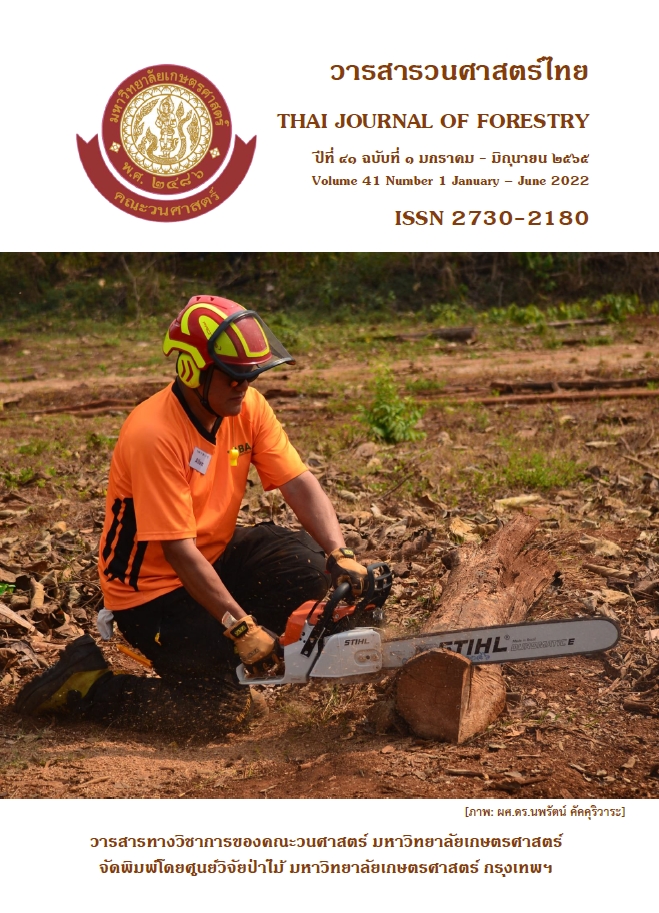การทดแทนของสังคมพืชที่มีอายุต่างกันในสวนยางพารา ในพื้นที่จังหวัดสงขลาและพัทลุง
Main Article Content
บทคัดย่อ
สวนยางพาราในประเทศไทยส่วนใหญ่ปลูกแบบเชิงเดี่ยว เกษตรกรจำนวนน้อยรายสนใจทำสวนยางพาราวนเกษตร ข้อมูลเกี่ยวกับพรรณไม้ท้องถิ่นที่สามารถเจริญเติบโตได้ดีในสวนยางพารายังมีอยู่จำกัด การวิจัยนี้เป็นการศึกษาสังคมพืชที่ขึ้นทดแทนมีอายุแตกต่างกันในสวนยางพาราที่สำหรับเป็นข้อมูลในการเลือกชนิดไม้สำหรับปลูกในสวนยางพารา โดยวางแปลงขนาด 10 x 10 เมตร จำนวน 10-77 แปลงในแต่ละพื้นที่ ในแต่ละแปลงทำการวัดขนาดเส้นผ่านศูนย์กลางของต้นไม้ที่มีขนาดเส้นผ่านศูนย์กลางตั้งแต่ 1 ซม. ขึ้นไปในสวนยางพารา 3 พื้นที่คือ (1) บริเวณร้านอาหารป่ายาง (อายุการทดแทน 10-12 ปี) (2) ตำบลตะโหมด (22 ปี) และ (3) พื้นที่อนุรักษ์พันธุกรรมพืชเขาคอหงส์ (40 ปี) คำนวณค่าดัชนีความสำคัญและดัชนีความหลากหลาย พบว่าโครงสร้างสังคมพืชมีความแตกต่างกันระหว่างพื้นที่ ชนิดไม้ที่มีค่าดัชนีความสำคัญสูงในพื้นที่ 1 คือพลับพลา นกนอน และบุนนาคคอหงส์ พื้นที่ 2 คือ นวล ขี้ใต้ และเม่า พื้นที่ 3 คือ บุนนาคคอหงส์ พลับพลา และขวาด โดยพบกะทังใบใหญ่ ตังหน และเชียดทั้งสามพื้นที่ สังคมพืชในสวนยางพาราคล้ายคลึงกันมากขึ้นเมื่ออายุของการทดแทนสูงขึ้น ระยะห่างจากป่าธรรมชาติและอายุของการทดแทนมีอิทธิพลต่อดัชนีความหลากหลาย ทั้งสามพื้นที่มีความหนาแน่นสัมพัทธ์ของชนิดไม้ที่กระจายเมล็ดโดยสัตว์แปรผันในช่วง 50-85% พรรณไม้ที่เติบโตในพื้นที่ตะโหมดได้ดีควรเป็นพรรณไม้แนะนำเพื่อปลูกในสวนยางพาราที่ดินคุณภาพต่ำและเป็นกรดค่อนข้างสูง
Downloads
Article Details

อนุญาตภายใต้เงื่อนไข Creative Commons Attribution-NonCommercial-NoDerivatives 4.0 International License.
ข้าพเจ้าและผู้เขียนร่วม (ถ้ามี) ขอรับรองว่า ต้นฉบับที่เสนอมานี้ยังไม่เคยได้รับการตีพิมพ์และไม่ได้อยู่ในระหว่างกระบวนการพิจารณาตีพิมพ์ลงในวารสารหรือสิ่งตีพิมพ์อื่นใด ข้าพเจ้าและผู้เขียนร่วม (ถ้ามี) ยอมรับหลักเกณฑ์และเงื่อนไขการพิจารณาต้นฉบับ ทั้งยินยอมให้กองบรรณาธิการมีสิทธิ์พิจารณาและตรวจแก้ต้นฉบับได้ตามที่เห็นสมควร พร้อมนี้ขอมอบลิขสิทธิ์ผลงานที่ได้รับการตีพิมพ์ให้แก่วารสารวนศาสตร์ คณะวนศาสตร์ มหาวิทยาลัยเกษตรศาสตร์ กรณีมีการฟ้องร้องเรื่องการละเมิดลิขสิทธิ์เกี่ยวกับภาพ กราฟ ข้อความส่วนใดส่วนหนึ่ง หรือ ข้อคิดเห็นที่ปรากฏในผลงาน ให้เป็นความรับผิดชอบของข้าพเจ้าและผู้เขียนร่วม (ถ้ามี) แต่เพียงฝ่ายเดียว และหากข้าพเจ้าและผู้เขียนร่วม (ถ้ามี) ประสงค์ถอนบทความในระหว่างกระบวนการพิจารณาของทางวารสาร ข้าพเจ้าและผู้เขียนร่วม (ถ้ามี) ยินดีรับผิดชอบค่าใช้จ่ายทั้งหมดที่เกิดขึ้นในกระบวนการพิจารณาบทความนั้น”
เอกสารอ้างอิง
Achard, F., Eva, H.D., Stibig, H.J., Mayaux, P., Gallego, J., Richards, T., Malingreau, J.P. 2002. Determination of deforestation rates of the world humid tropical forests. Science 297: 999-1002.
Bumrungsri, S., Sripao-raya, E., Leelatiwong, C.. 2006. A quantitative analysis of plant community structure in an abandoned rubber plantations on Kho-Hong Hill, southern Thailand. Songklanakharin Journal of Science and Technology 28: 479-491.
Charoenjiratrakul, S., Satsue, P, Romyen, I. 2014. Economic Analysis in Adding Green Area in Rubber Farms. A final report to Thailand Research Fund, Bangkok. (in Thai)
Khohong Conservation Initiative, Social Science Research Unit, Faculty of Environmental Management, Prince of Songkla University. 2017. Rubber Agroforest for the Sustainable for Community in Southern Thailand. Power for Sustainable Future Foundation. Bangkok. (in Thai)
Nattharom, N., Roongtawanreongsri, S., Bumrungsri, S. 2016. Ecosystem services of rubber agroforestry system: A review, pp. 405-413.
In S. Picken, ed. Proceeding of The Asian Conference on the Social Science 2016. The International Academic Forum. Nagoya, Japan.
Nattharom, N., Roongtawanreongsri, S., Bumrungsri, S. 2020. Growth prediction for rubber tree and intercropped timber trees to facilitate environmental services valuation in south Thailand. Biodiversitas 21: 2019-2034.
Office of Agricultural Economics. 2019. Agricultural Information year 2018. Ministry of Agriculture and Cooperation. Agricultural Statistic, Bangkok. (in Thai)
Rubber Research Institute. 2018. Rubber Research 2018. Rubber Authority of Thailand, Bangkok. (in Thai)
Sorensen, B. 1984. Physical measurements as risk indicators for low-back trouble over a one year period. Journal of Spinal Disorders and Techniques 9: 106-119.
Sridith, K., Laongpol, C. 2002. The preliminary study on some natural plant communities of the sandbars along eastern coast of peninsular Thailand. Songklanakharin J. Sci. Technol. 25: 103-113.
Tanthana, N. 1998. Natural Succession in Abandoned Rubber Plantation. M.S. Thesis. Prince of Songkla University. (in Thai)


